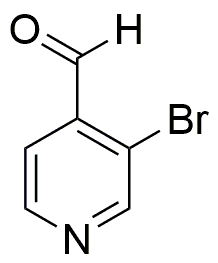3-Bromopyridine-4-carboxaldehyde is widely utilized in research focused on:
- Synthesis of Pharmaceuticals: This compound serves as an important intermediate in the synthesis of various pharmaceutical agents, particularly those targeting neurological disorders.
- Development of Agrochemicals: It is used in the formulation of agrochemicals, enhancing the efficacy of pesticides and herbicides through its unique chemical properties.
- Material Science: The compound is employed in the development of advanced materials, including polymers and coatings, due to its ability to modify surface properties.
- Organic Synthesis: As a versatile building block, it plays a critical role in organic synthesis, allowing researchers to create complex molecular structures efficiently.
- Fluorescent Probes: It is utilized in the creation of fluorescent probes for biological imaging, providing valuable insights into cellular processes and disease mechanisms.
General Information
Properties
Safety and Regulations
Applications
3-Bromopyridine-4-carboxaldehyde is widely utilized in research focused on:
- Synthesis of Pharmaceuticals: This compound serves as an important intermediate in the synthesis of various pharmaceutical agents, particularly those targeting neurological disorders.
- Development of Agrochemicals: It is used in the formulation of agrochemicals, enhancing the efficacy of pesticides and herbicides through its unique chemical properties.
- Material Science: The compound is employed in the development of advanced materials, including polymers and coatings, due to its ability to modify surface properties.
- Organic Synthesis: As a versatile building block, it plays a critical role in organic synthesis, allowing researchers to create complex molecular structures efficiently.
- Fluorescent Probes: It is utilized in the creation of fluorescent probes for biological imaging, providing valuable insights into cellular processes and disease mechanisms.
Documents
Safety Data Sheets (SDS)
The SDS provides comprehensive safety information on handling, storage, and disposal of the product.
Product Specification (PS)
The PS provides a comprehensive breakdown of the product’s properties, including chemical composition, physical state, purity, and storage requirements. It also details acceptable quality ranges and the product's intended applications.
Certificates of Analysis (COA)
Search for Certificates of Analysis (COA) by entering the products Lot Number. Lot and Batch Numbers can be found on a product’s label following the words ‘Lot’ or ‘Batch’.
*Catalog Number
*Lot Number
Certificates Of Origin (COO)
This COO confirms the country where the product was manufactured, and also details the materials and components used in it and whether it is derived from natural, synthetic, or other specific sources. This certificate may be required for customs, trade, and regulatory compliance.
*Catalog Number
*Lot Number
Safety Data Sheets (SDS)
The SDS provides comprehensive safety information on handling, storage, and disposal of the product.
DownloadProduct Specification (PS)
The PS provides a comprehensive breakdown of the product’s properties, including chemical composition, physical state, purity, and storage requirements. It also details acceptable quality ranges and the product's intended applications.
DownloadCertificates of Analysis (COA)
Search for Certificates of Analysis (COA) by entering the products Lot Number. Lot and Batch Numbers can be found on a product’s label following the words ‘Lot’ or ‘Batch’.
*Catalog Number
*Lot Number
Certificates Of Origin (COO)
This COO confirms the country where the product was manufactured, and also details the materials and components used in it and whether it is derived from natural, synthetic, or other specific sources. This certificate may be required for customs, trade, and regulatory compliance.


